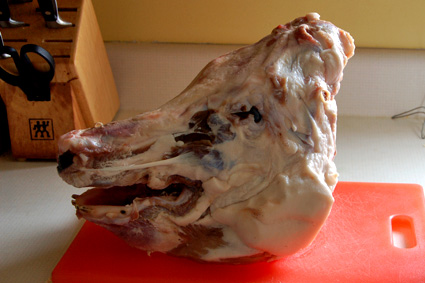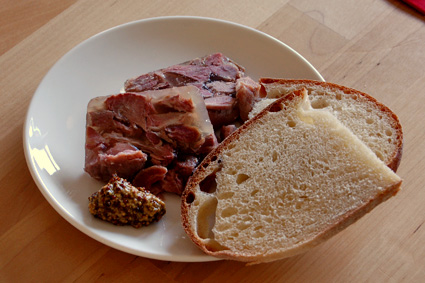It's difficult to state it better than the late English food writer, Jane Grigson:
"Anyone can grill a steak or chop; the cheaper cuts require careful and sophisticated cooking. This does not mean that the methods are difficult or tortuous, but they do require judgement and care over detail. Lack of proper care ... and insensitivity to flavour make many manufactured meat dishes in England uneatable. This commercial debasement ... has misled people into feeling that only the expensive parts of a pig are worth eating."It works as a fairly general statement, but Grigson is referring specifically to dishes such as fromage de tête. Brawn, in her native England. Head cheese here in the States.
The last - and in fact only - time that I can recall having head cheese was at a tiny Alsatian restaurant in Strasbourg. I asked the owner to bring me the sorts of food I wouldn't find outside of Alsace, and my appetizer was a well-made head cheese. From a pig's head, he told me; not from a calf's head, like you'd find more commonly elsewhere.
It wasn't until recently that I had everything I needed1 to make my own. Important things on that list: a very large pot; a meat saw2; and this:

One pig's head. In this case, skinned, since it seems nigh impossible to find someone who'll sell a hog with skin on.3 A shame, since the skin's so tasty, but what can you do? I got the head for pretty much free; the farmers said that I was welcome to have as many as I like in the future. The butcher just throws them out, and wouldn't mind in the least.
It doesn't look so terrifying in this picture, though getting up close and personal - with the saw, in particular - made the source of my upcoming meals pretty damn clear. (Like when you find that jamming a thumb into an eye socket gives a better grip.) What made it look something like a horror film prop was when I'd sawn the nose off, exposing some truly fascinating shapes of cavities within the skull. That and big ol' pig teeth. No, I didn't take any pictures.
Brief aside: sawing through a skull is serious work. Cutting turkey carcasses to fit into gallon-size freezer bags? Easy. Trying to hold meat and bone stable enough while ensuring my fingers stay intact? It's enough to make me dream of owning a band saw.
Once that's done, the cooking process couldn't be much simpler. Both Ruhlman and Polcyn's Charcuterie and Grigson's Charcuterie and French Pork Cookery recommend much the same process; I followed the former, because they're more precise - and use easier-to-measure ingredients, like pink salt instead of saltpeter - and I don't have to worry about British-American conversions. In brief, making head cheese goes like this:
- Brine a pig's head and trotters, or, in my case, a fresh hock.4 Pink salt's optional, though the pink color and cured flavor are nice. Got a cured tongue? Add it to the cooking pot, but not the brine.
- Simmer for hours in a large pot with aromatics (garlic, leek, onion), spices (quatre épices - white pepper, cloves, nutmeg, ginger; peppercorns), herbs (parsley, bay, thyme), and a good bit of white wine, plus plenty of water to cover. It's done when the jaw detaches easily.
- Remove the meat from the cooking liquid, and strain it. Reduce the liquid until it's gelatin-rich enough to set into a firm gel when chilled. Dice the cooked meats,5 and place in a mold with enough aspic to cover. Chill overnight before slicing.

But with some fresh bread and mustard, it's excellent stuff. A green salad and vinaigrette wouldn't hurt, either.
As for the name: according to Alan Davidson's The Oxford Companion to Food, it "is usually moulded in a cylindrical shape, like a cheese". I'd really hoped for a more colorful - even potentially bogus - story for it, but I guess that'll have to do.
* * * * *
1Including the time and inclination.
2To help, uh, fit the head into the pot. Even the 4-gallon stockpot that I have couldn't handle the whole thing. I could have used the 10-gallon pot I use for brewing beer, except that it's difficult to clean, especially when coated with cooked-on protein-y junk.
3As I understand it, scraping the hide clean is more difficult and time-consuming than simply skinning the carcass.
4You can't get real trotters - feet - unless the pig's been scraped clean. They have less meat and more connective tissue than hocks, which is of some benefit here, but you work with what you've got. In my case, half a dozen hocks, though only one went into this batch. Even so, it may have furnished as much meat as the entire head did.
5Finding all of the meaty bits around the head is kind of fun. Who knew there was a (relatively) good-sized muscle running up behind the eye, protected by an arch of skull? Plus, you can see where all of the nerves - eyes, nose, etc. - disappear into little openings to reach the brain. Sadly, I couldn't figure out how to extract the brain without making a serious mess, so I couldn't cook that up. Next time, maybe? (Grigson heartily recommends it.)

4 comments:
awesome.
'Cause it is.
How interesting...what a feat. Talk about a sense of accomplishment! I've never had it--does it takes like ham? I'd be interested to know. Great pictures.
takes = taste
It's late and I've had 2 glasses of wine...
Post a Comment